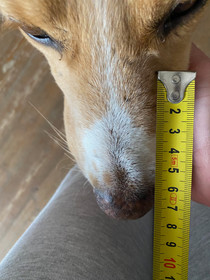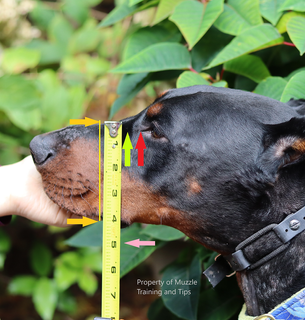

Closed Measurements
MTT has a particular way to measure your dog, which we believe is the best way to get a good fit; At the same time, some places may suggest differently, so when we refer to measuring your dog, the methods listed below are the only ones MTT use as it has been changed and improved by experience over the last two years. This page will cover measuring length, width, closed height and closed circumference.
Disclaimer: Firstly if your dog is a bite risk to you or doesn't allow hands/things near their face we DO NOT RECOMMEND MEASURING them. Putting your dogs through unnecessary stress when it is possible to use other methods (listed below). On another note please DO NOT use your hands to open your dog's mouth. You should not measure if you have to force any more than a comfortable level.
How To Get Your Dogs Closed Measurements (4 Parts)
1: Length
Length measurement is the exact length of your dog's nose, taken down from the eyes to the tip of the nose. We recommend measuring 0.5” down from the eyes, depending on the dog and where you want the muzzle to sit this may slightly differ. You can see in the photo there is a .5" gap between the eyes and the measuring tape.
Length is measured exact because the 'adding length' to ensure it doesn't sit on the tip of the nose is done when sizing the muzzle. You need exact measurements to compare to the measurements of the muzzle. If your dogs exact length is 3.25" you need to find a muzzle that is roughly 3.75" to add the room to keep off the nose.
2: Width
The width is the exact same as length but the other way over the nose. It is the imaginary straight line from one side to the other. It is not measured over the nose with a curved tape measure. It would be easier As an example, the widest width we have gotten is only 5.5" as an exact measurement which was a very large dog and the smallest is 1".
Width is more relaxed than the other measurements as most muzzles can be modified and most dogs do okay with a slightly wide muzzle, however a muzzle that is too narrow will likely not work for any dog since it will restrict pant as well as being very uncomfortable.
3: Closed Height
This is a straight-forward measurement and exact. It does not include jowls, yawning, mouth partially open, etc. To learn why see the Jowly Dogs tab. Closed height is taken up the side of the snout from the top to the bottom at the tallest part (usually closer to the eyes). The tape measure should not be curled at all.
Ensuring this measurement is correct is really important when sizing a muzzle because an incorrect closed height can instantly give you the wrong fit if approximating the open measurements when sizing and measuring. It can also throw off the open measurements you get if giving it to MTT Programs since the pant may look bigger than only 2" more height than your dogs closed mouth, but really closed height may actually be less than given, thus giving a bigger open height difference, which is explained more in the approximating tab.
4: Closed Circumference
This is measured around the base of the mouth at the widest/tallest part with a soft measuring tape or a string. Straightforward measurement to get. Taken snug, not tight or loose. If they have jowls, just do it snug and read over the jowly dog tabs.
Make sure you measure at the widest/tallest part of the snout. You will need to use a soft tape measure or a string then measure the string with your straight tape measure.
This measurement is not really helpful when paired with the other measurements, though it is a good one to get IF you cannot get the others like width and closed height.



































